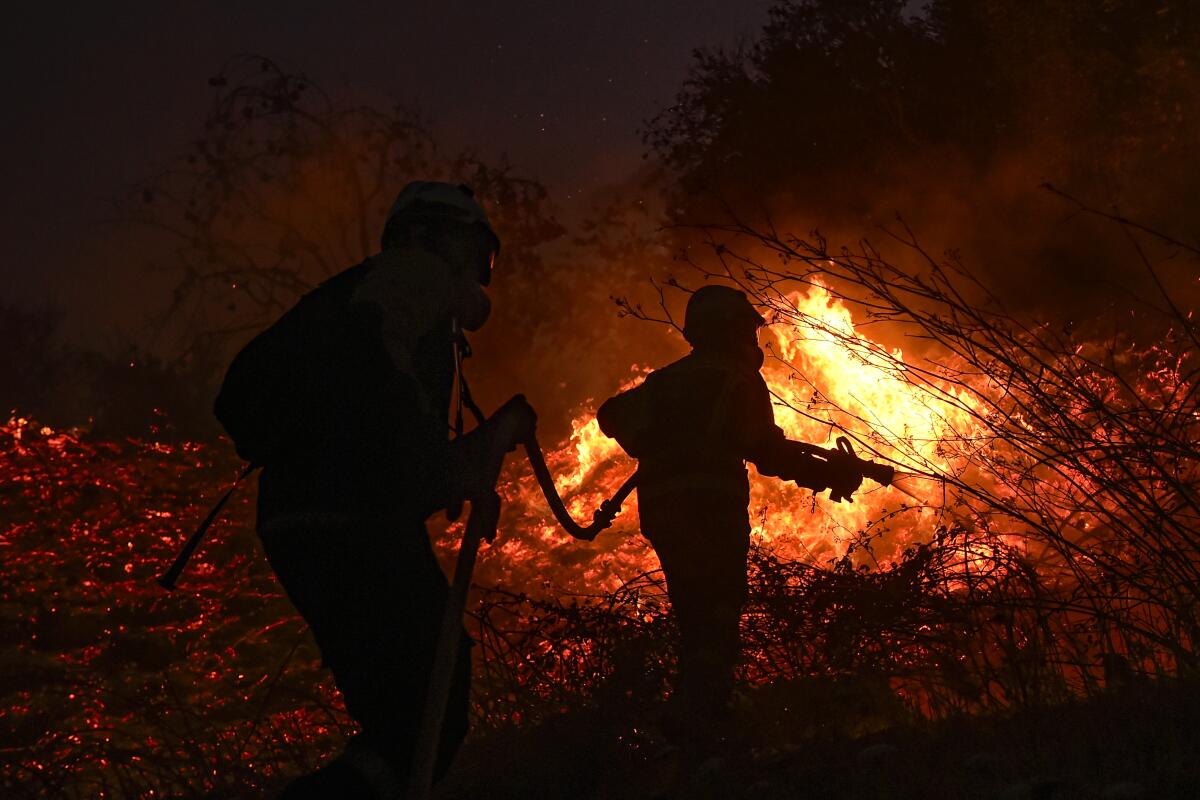Earth just had its warmest August — and summer — on record, spurring dire warnings

- Share via
Amid a backdrop of extreme weather events and devastating wildfires, federal and international officials this week issued dire warnings about record-setting temperatures and the worsening effects of climate change.
Last month was the planet’s warmest August on record, and the Northern Hemisphere experienced its hottest meteorological summer, the National Oceanic and Atmospheric Administration announced Thursday.
“Global marine heat waves and a growing El Niño are driving additional warming this year, but as long as emissions continue driving a steady march of background warming, we expect further records to be broken in the years to come,” read a statement from NOAA chief scientist Sarah Kapnick.
The warning comes on the heels of a study published this week in the journal Science Advances, which found that the planet has transgressed 6 out of 9 boundaries for processes deemed critical for maintaining the stability and resilience of the Earth system as a whole.
The boundaries include biosphere integrity, freshwater changes and climate change. Two boundaries — air pollution and ocean acidification — are close to being breached, while only one, atmospheric ozone, has slightly recovered.
“Earth is now well outside of the safe operating space for humanity,” the study said.
According to NOAA researchers, global surface temperatures last month were 2.25 degrees above the 20th century average of 60.1 degrees, surpassing the previous record, from August 2016, by more than half a degree.
“That to me is a really huge jump from one record to the next,” said Ellen Bartow-Gillies, a physical scientist with NOAA’s National Centers for Environmental Information. She noted that graphs of temperature records dating to the 1850s show a steady climb — accelerating during the industrial era — but that August 2023 was “on a point of its own, essentially.”
In addition to being the warmest August in NOAA’s 174 years of records, the month saw the third-highest temperature anomaly of any month on record, meaning the third-highest from its average.
The hot month continued a trend that began weeks earlier, with June and July both setting monthly temperature records.
Collectively, June through August — a period defined as meteorological summer in the Northern Hemisphere and meteorological winter in the Southern Hemisphere — was the warmest on record. During that period, the Northern Hemisphere was 2.59 degrees above average.
What’s more, the last 10 June through August periods are the 10 warmest such periods on record. The year-to-date global surface temperature — January through August — ranked as the second warmest on record.
Marked by record-setting heat waves, major wildfires, and melting sea ice, July saw global average temperatures soar 2.02 degrees above average.
The report confirmed what millions of people experienced in recent months, including record-shattering heat waves that touched nearly every corner of the planet. Asia, Africa, North America and South America had their warmest August on record, as did the Arctic. Europe and Oceania — a region that includes Australia — had their second-warmest August on record, the report said.
It wasn’t just the land that boiled: August set a record for the highest monthly sea surface temperature anomaly — 1.85 degrees above average. The warming oceans contributed to shrinking sea ice, with Antarctica experiencing its fourth consecutive month with the lowest sea ice extent on record. Globally, sea ice extent in August was about 550,000 square miles less than the previous record low, set in August 2019.
“We’ve seen unprecedented warmth in the global ocean, and that’s definitely alarming because it has ramifications beyond just the scope of the ocean,” Bartow-Gillies said. “Not only are you disturbing marine habitats, but you’re affecting storm creation, you’re creating more instability in some areas, you’re creating flooding events in other areas. There’s a whole host of issues that come along with these warmer ocean surface temperatures that we’re seeing.”
Indeed, the report comes amid a series of brutal, globe-spanning natural disasters.
This week, a Mediterranean storm caused catastrophic flooding in Libya, killing more than 11,000 people. In Canada, wildfires burned through more than 42 million acres of boreal forests this summer, and several are still burning. On Maui, Hawaii, last month, a fast-moving wildfire killed at least 115 people, with more than 60 still missing.
In the U.S. alone, NOAA researchers confirmed 23 weather and climate events that each cost $1 billion or more this year — the all-time highest number of billion-dollar disasters on record.
Though global warming was not the singular cause of any of these disasters, heating of the Earth continues to increase the likelihood of extreme weather events and wildfire worldwide.
“We know that pushing the climate into this state of extreme heat causes a lot of instability across the climate, and causes more inconsistent weather,” Bartow-Gillies said.
More than 6.5 billion people — 81% of the global population — experienced climate change-attributed heat in July 2023, according to a new report from Climate Central.
In reviewing the dizzying data through August, officials said there is now a 95% chance that 2023 will rank among the two warmest years on record.
“The scientific evidence is overwhelming — we will continue to see more climate records and more intense and frequent extreme weather events impacting society and ecosystems, until we stop emitting greenhouse gases,” read a statement from Samantha Burgess, deputy director of the European Union’s Copernicus Climate Change Service, which also determined that this summer was the hottest on record.
Bartow-Gillies said that it’s difficult to quantify how much of the recent warming is due to El Niño — a climate pattern in the tropical Pacific associated with warmer global temperatures — and how much is due to climate change, but that both are playing a part.
“These El Niño conditions that we’re seeing starting to develop and intensify, combined with the general trend of climate change, have sort of laid the groundwork for this extreme heat that we’ve seen over the last few months,” she said. “It becomes like a positive feedback loop, where everything is encouraging one another to reach peak intensity.”
According to the latest forecast from the NOAA, El Niño will stick around through at least early 2024.











